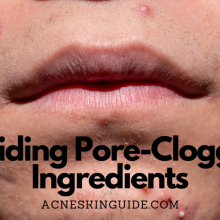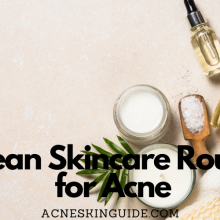Acne Face Mapping | Acne Skin Guide
Acne face mapping is an ancient practice rooted in traditional healing systems like Traditional Chinese Medicine and Ayurveda. It associates the location of pimples and breakouts on the face with potential underlying bodily imbalances or issues in organs and systems. For example, forehead breakouts may signify digestive problems, while cheek acne could indicate hormonal or respiratory issues. Though based on traditional beliefs, modern research supports some connections between acne patterns and factors like diet, stress, gut health, hormones, and environmental exposures.
However, the practice faces criticism for oversimplifying acne’s complex nature. To benefit from acne face mapping, a holistic, personalized approach involving tracking breakout patterns, dietary/lifestyle changes, natural remedies, and professional guidance when needed is recommended. Overall, it encourages exploring internal causes of acne while balancing traditional wisdom with scientific advancement for clearer skin.
#1 Recommended Acne Treatment | #2 Recommended Acne Treatment |
 |  |

Mapping Your Acne: Bridging Traditional Wisdom and Modern Science
The Ancient Practice of Acne Face Mapping
Acne, a common skin condition that affects millions worldwide, can be a frustrating and sometimes embarrassing experience. While topical treatments and medications can help manage breakouts, understanding the potential underlying causes can provide valuable insights into achieving long-term, holistic acne management. This is where the practice of acne face mapping comes into play.
Traditional Roots and Modern Connections
Rooted in ancient traditional practices, acne face mapping is based on the belief that the location of pimples and breakouts on the face may correspond with specific organs or systems in the body. This concept has been embraced by various traditional healing systems, including Traditional Chinese Medicine (TCM), Ayurveda, and Greco-Arabic medicine.
Decoding the Acne Zones
According to these beliefs, different facial zones are associated with different internal imbalances or issues. For instance, breakouts on the forehead may signify digestive problems, while cheek acne could indicate hormonal imbalances or respiratory issues. Chin and jawline acne are often linked to fluctuating hormones, particularly during menstrual cycles or hormonal shifts. Nose acne, on the other hand, may result from improper cleansing routines or clogged pores.
Scientific Insights and Modern Research
While the origins of acne face mapping lie in traditional wisdom, modern scientific research has also shed light on the potential connections between acne patterns and underlying causes. Studies have explored the links between diet, stress, gut health, hormonal imbalances, and environmental factors, and their impact on acne development.
Dietary Triggers and Inflammation
Certain dietary triggers, such as dairy products, processed foods high in refined carbohydrates, and foods with a high glycemic index, have been associated with increased inflammation and acne flare-ups.
Stress and Hormonal Imbalances
Similarly, chronic stress can disrupt the body’s natural defenses, leading to hormonal imbalances and a weakened skin barrier, potentially contributing to breakouts.
The Gut-Skin Connection
The gut-skin connection has also gained attention in recent years, with research suggesting that an imbalanced gut microbiome may play a role in acne development. This link emphasizes the importance of maintaining a healthy gut through a balanced diet and probiotic supplementation.
Environmental Factors and Acne Patterns
Furthermore, environmental factors like pollution, climate changes, and exposure to certain chemicals or cosmetic products can also impact acne patterns, potentially exacerbating breakouts in specific facial zones.
Balancing Traditional Wisdom and Modern Science
While acne face mapping offers a framework for understanding potential connections between breakout locations and internal factors, it’s important to approach it with an open mind and balance it with modern scientific insights. Some experts argue that the practice oversimplifies the complex nature of acne and that individual experiences may vary.
The Purging Phenomenon: Fact or Fiction?
One potential downside of acne face mapping is the concept of “purging” acne, which suggests that certain treatments or dietary changes may initially worsen breakouts as the body “purges” toxins or imbalances. While this phenomenon may occur in some cases, it’s crucial to differentiate between true purging and adverse reactions, which could indicate the need to adjust or discontinue a particular approach.
Seeking Professional Guidance
Additionally, severe or persistent acne may require professional guidance from a dermatologist or healthcare provider, as it could be a symptom of an underlying medical condition or hormonal disorder.
A Personalized and Holistic Approach
To fully benefit from acne face mapping, it’s essential to adopt a personalized and holistic approach. This may involve tracking and documenting acne patterns over time, making dietary and lifestyle adjustments, incorporating gentle and natural skincare routines, and exploring targeted supplements or herbal remedies based on identified acne zones.
Natural Remedies and Prevention Tips
Natural remedies and prevention tips that may be beneficial include:
- Anti-inflammatory dietary choices: Incorporate foods rich in antioxidants, omega-3 fatty acids, and probiotics, such as leafy greens, berries, fatty fish, and fermented foods.
- Stress management techniques: Practices like meditation, yoga, or deep breathing exercises can help reduce stress levels and promote overall well-being.
- Gentle skincare routine: Opt for non-comedogenic, oil-free, and sulfate-free products, and avoid harsh scrubbing or over-exfoliating, which can irritate the skin.
- Targeted supplements and herbs: Zinc, probiotics, and herbal remedies like tea tree oil, green tea, and turmeric may help address specific acne types or zones.
- Lifestyle adjustments: Prioritize adequate sleep, regular exercise, and avoiding triggers like tight clothing or harsh cosmetic products.
Embracing a Comprehensive Approach
By combining acne face mapping with a holistic approach and modern scientific insights, individuals can gain a deeper understanding of their unique acne patterns and develop personalized strategies for achieving clearer, healthier skin.
When to Seek Professional Help
It’s important to note that while acne face mapping can offer valuable insights, it should not replace professional medical advice, particularly for severe or persistent cases. Consulting with a dermatologist or healthcare provider can help rule out any underlying medical conditions and provide tailored treatment plans.
Conclusion: A Balanced and Open-Minded Perspective
In conclusion, acne face mapping is a practice that encourages individuals to explore the potential connections between breakout locations and internal factors, empowering them to take a holistic approach to acne management. By embracing traditional wisdom while remaining open to modern scientific advancements, individuals can navigate their acne journey with a more comprehensive understanding and a personalized, well-rounded approach.
#1 Recommended Acne Treatment | #2 Recommended Acne Treatment |
 |  |
Summary and FAQs
How accurate is acne face mapping, and how reliable are the interpretations of different facial zones?
The accuracy and reliability of acne face mapping interpretations are still debated, as there is limited large-scale scientific research in this area. While the practice is rooted in ancient traditional beliefs, its efficacy is primarily based on anecdotal evidence and observational studies.
Some studies have found correlations between certain acne locations and underlying factors, such as hormonal imbalances or digestive issues. However, these correlations are not definitive, and individual experiences may vary significantly.
Critics argue that acne face mapping oversimplifies the complex nature of acne, which can be influenced by various factors, including genetics, lifestyle, and environmental exposures. Additionally, the interpretations of facial zones can be subjective, and there may be overlapping or conflicting explanations for different acne locations.
Proponents of acne face mapping acknowledge that it is not a diagnostic tool but rather a framework for understanding potential connections and identifying areas that may require further investigation or lifestyle adjustments. They emphasize the importance of combining face mapping with a holistic approach that considers individual circumstances and modern scientific insights.
While acne face mapping can provide valuable insights and serve as a starting point for exploring underlying causes, it should be approached with an open mind and balanced with professional medical advice, particularly for severe or persistent cases. Ultimately, the reliability of interpretations may depend on individual experiences and the ability to accurately track and document acne patterns over time.
Can acne face mapping be used to diagnose underlying medical conditions?
No, acne face mapping alone cannot be used to definitively diagnose underlying medical conditions. It is a practice rooted in traditional beliefs that associates acne patterns on the face with potential internal imbalances or issues, but it does not provide a clinical diagnosis.
Acne face mapping can, however, provide clues or insights that may prompt further investigation or medical evaluation. For example, if someone consistently experiences severe acne breakouts on the jawline or chin, which are often associated with hormonal imbalances, it could suggest the need to check for conditions like polycystic ovary syndrome (PCOS) or other hormonal disorders.
Similarly, persistent forehead acne, which is traditionally linked to digestive issues, could indicate the need to explore potential gastrointestinal problems or food intolerances. However, these associations are not conclusive and require professional medical assessment and diagnostic tests.
While acne face mapping can serve as a complementary tool for understanding potential connections between acne patterns and internal factors, it should not be relied upon as a sole diagnostic method. Underlying medical conditions often involve complex interactions of various physiological systems and require a comprehensive evaluation by a qualified healthcare professional.
Dermatologists, endocrinologists, or other medical specialists may consider acne patterns as part of their overall assessment, but they typically rely on a combination of medical history, physical examination, laboratory tests, and other diagnostic procedures to arrive at an accurate diagnosis and develop an appropriate treatment plan.
It is important to consult with healthcare professionals, especially for severe, persistent, or unusual acne cases, as they can rule out or identify any underlying medical conditions and provide appropriate medical interventions and guidance.
How does acne face mapping differ for men and women?
Acne face mapping principles and interpretations can differ slightly for men and women due to hormonal differences and gender-specific factors that influence acne development.
Here are some key differences in acne face mapping for men and women:
- Hormonal factors:
Women tend to experience more hormonal fluctuations throughout their lives, such as during menstrual cycles, pregnancy, and menopause. These fluctuations can lead to hormonal acne, which is often concentrated on the chin and jawline areas. In contrast, men typically have more stable hormone levels, and their acne patterns may be less influenced by hormonal changes. - Polycystic Ovary Syndrome (PCOS):
PCOS is a hormonal disorder that affects women and can contribute to acne, particularly on the jawline, chin, and cheeks. Acne in these areas for women may be an indicator of PCOS or other hormonal imbalances, which men do not typically experience. - Skin structure and oil production:
Men generally have thicker skin and produce more sebum (oil) due to higher levels of testosterone. This can make them more prone to acne on the forehead, nose, and back, which are areas with higher concentrations of sebaceous glands. - Hair growth patterns:
Increased hair growth, particularly on the chin and jawline in women, can contribute to acne in these areas due to the transfer of oils and bacteria from the hair to the skin. - Skincare and grooming habits:
Different grooming practices, such as shaving or the use of certain hair products, can impact acne patterns in men and women differently. For example, shaving can cause ingrown hairs and acne on the jawline and neck for men.
While the basic principles of acne face mapping may apply to both genders, the interpretations and emphasis on certain facial zones may vary. For women, more attention may be given to hormonal acne patterns on the chin, jawline, and cheeks, while for men, the focus may be on areas like the forehead, nose, and back.
It’s important to note that individual experiences can vary, and acne face mapping should be approached with an open mind and combined with personalized skincare routines, lifestyle adjustments, and professional medical advice when necessary.
Can acne face mapping be applied to other areas of the body?
Yes, the principles of acne face mapping can potentially be applied to other areas of the body affected by acne, although the interpretations and associations may differ from those used for the face.
While acne face mapping traditionally focuses on the face, which is the most visible and commonly affected area, acne can also occur on other parts of the body, such as the back, chest, shoulders, and even the buttocks and thighs.
Here are some ways acne face mapping concepts can be extended to other body areas:
- Back acne (bacne):
Back acne is often associated with hormonal imbalances, excessive sweating, and friction from clothing or backpacks. The location of bacne may provide insights into potential underlying causes, such as hormonal fluctuations or issues with the adrenal glands or kidneys, according to traditional beliefs. - Chest and shoulder acne:
Acne on the chest and shoulders can be linked to hormonal changes, particularly in teenagers and young adults. Additionally, these areas are prone to sweat and friction, which can contribute to clogged pores and acne development. - Buttocks and thigh acne:
Acne in these areas may be associated with friction from tight clothing, poor hygiene, or hormonal imbalances. Some traditional practices suggest that acne on the buttocks and thighs could be related to digestive or reproductive system issues.
While the specific interpretations and associations may vary from those used for facial acne, the general principle of observing acne patterns and locations can be applied to other body areas. However, it’s important to note that these interpretations are based on traditional beliefs and may not be universally accepted or scientifically validated.
Additionally, acne on other body areas may have different contributing factors compared to facial acne, such as excessive sweating, friction from clothing or equipment, and different hormone sensitivity in various regions of the body.
When applying acne face mapping principles to other body areas, it’s crucial to consider individual circumstances, consult with healthcare professionals, and adopt a holistic approach that addresses potential underlying causes and lifestyle factors contributing to acne development.
Are there any specific techniques or tools recommended for accurately tracking acne patterns?
Yes, there are several techniques and tools that can help accurately track and document acne patterns, which is essential for effectively applying the principles of acne face mapping. Here are some recommended methods:
- Acne mapping charts or templates:
These are visual diagrams or charts that provide an outline of the face or body areas, allowing you to mark the locations of individual pimples, whiteheads, or cystic acne. You can find printable acne mapping charts online or create your own using a simple outline. - Acne tracking apps:
Several mobile apps are designed specifically for tracking acne patterns. These apps often provide digital face or body maps where you can log the location, severity, and other details of your breakouts. Some popular acne tracking apps include Acne Diary, Acne.AI, and Spot Acne. - Photo documentation:
Taking regular photos of your face or affected areas can provide a visual record of your acne patterns over time. Try to take photos in consistent lighting and angles to make comparisons easier. You can use a dedicated acne tracking app or simply store the photos in a designated album on your phone or computer. - Journaling:
Keeping a written journal can be a simple yet effective way to document your acne patterns, potential triggers, and any associated factors such as diet, stress levels, or menstrual cycle. Note the dates, locations, and any other relevant observations. - Calendars or planners:
You can use a physical or digital calendar to mark the days when you experience breakouts and the affected areas. This can help identify potential patterns or cycles related to hormonal changes or other recurring factors. - Collaboration with healthcare professionals:
If you’re working with a dermatologist or other healthcare provider, share your acne tracking efforts with them. They may have specific tools or methods they recommend for accurately documenting your acne patterns, which can aid in developing an effective treatment plan.
Consistency is key when tracking acne patterns. Regular and detailed documentation can help you identify trends, potential triggers, and areas of concern that may require further attention or lifestyle adjustments. Additionally, having a clear record of your acne patterns can facilitate better communication with healthcare professionals and support a more personalized approach to managing your skin concerns.






